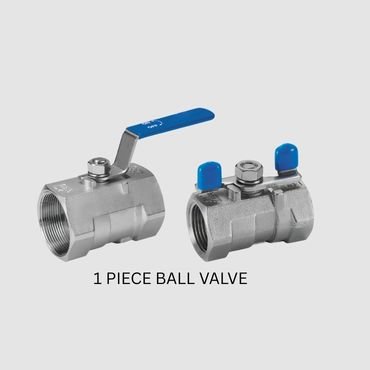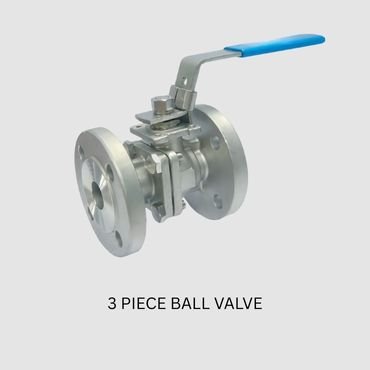Ball valves are indispensable in numerous industrial and commercial applications, offering reliable control over fluid and gas flow with a simple quarter-turn operation. These valves vary significantly depending on their construction, leading to specific advantages and limitations in the context of leakage. Among the most common types are 1-piece, 2-piece, and 3-piece ball valves.
Each design serves unique purposes, ranging from cost-efficient household use to high-pressure industrial applications requiring frequent maintenance. If you’re unsure about which type of valve is right for your project, this guide will clarify their differences and help you make an informed choice.
By the end of this article, you’ll understand the construction, applications, and benefits of 1-piece, 2-piece, and 3-piece ball valves to ensure you select the best fit for your system.
Understanding the Different Types of Ball Valves
At their core, ball valves regulate the flow of liquid or gas using a spherical ball with a hole (port) through its center. When aligned with the flow, the valve opens fully; when perpendicular, the flow stops.
The key distinction between a 1-piece, 2-piece, or 3-piece ball valve lies in how the body of the valve is constructed and maintained, significantly impacting performance, cost, and functionality.
1-Piece, 2-Piece, and 3-Piece Ball Valves Explained
Here’s an overview of the construction and characteristics of these ball valve types:
- 1-Piece Ball Valve
A compact, solid design with a single body for tight on/off control, often referred to as a 1 piece valve. Best for low-cost applications.
- 2-Piece Ball Valve
Features two separate components for easier disassembly and repair, offering more flexibility in industrial use.
- 3-Piece Ball Valve
Equipped with three distinct components and designed for maximum longevity, frequent maintenance, and high-pressure environments.
Now, we’ll examine each valve type in detail.
Choosing the Right Ball Valve: A Complete Guide
Selecting the appropriate ball valve for your system involves understanding its function, operating pressure, and maintenance needs. Here’s a breakdown of each type to help guide your decision.
1-Piece Ball Valves
Construction
A 1-piece ball valve features a single, molded body that encapsulates all components, including the ball and seats. It’s designed for durability but isn’t serviceable, meaning it must be replaced entirely if damaged.
Key Features
- The compact and lightweight design of a two piece ball valve can be advantageous in limited spaces.
- Generally available in reduced port designs, where the valve opening is smaller than the pipeline diameter. This restricts flow but minimizes manufacturing costs.
- Has a simple rotary handle for manual operation.
Applications
1-piece ball valves are perfect for Household plumbing often requires valves with either threaded or bolt and flange end connections. where flow efficiency isn’t crucial, and ongoing maintenance isn’t expected. For example:
- Residential water pipes.
- Low-pressure liquid transfer systems.
- Basic machinery with occasional flow adjustments.
Advantages
- Cost-effective for tight budgets.
- Leak-resistant due to its solid, single-piece body.
- Easy-to-install, space-saving design.
Limitations may arise when the valve consists of three separate components.
- Non-repairable; must be replaced if faulty.
- Limited to low-pressure environments and reduced flow capacity compared to a 3 piece ball valve.
2-Piece Ball Valves
Construction
The 2-piece ball valve consists of a primary valve body connected to an additional threaded or flanged section. This modular design allows for disassembly, making it a reliable option for maintenance.
Key Features
- Available in full port configurations, ensuring the valve opening matches the pipeline’s diameter for unrestricted flow.
- Offers bidirectional flow control, making it suitable for versatile systems.
Applications
2-piece ball valves excel in industrial environments Where occasional maintenance is required without removing entire pipelines, a valve with an efficient body design is crucial. Common uses include:
- Chemical handling of a three piece ball valve requires careful attention to detail. This type of valve is suitable for moderate pressures, offering reliable performance.
- Manufacturing setups where system adjustments are needed.
Advantages
- Easier to clean and maintain without replacing the entire valve unit.
- Allows full bore for smooth flow in critical systems, ensuring that the main body is designed for optimal performance.
Limitations
- May develop leaks over time due to multiple seams and gaskets.
- Slightly less compact than a 1-piece valve.
3-Piece Ball Valves
Construction
A 3-piece ball valve comprises a central valve body and two end connectors (threaded, welded, or flanged). The central body of the valve can be removed for cleaning or repairs without disrupting the attached pipelines.
Key Features
- Fully serviceable, with replaceable seals, seats, and internal components.
- Designed to handle intense wear and high pressure without pipeline disruption.
- Often equipped with full bore for unrestricted flow rates.
Applications
3-piece ball valves are preferred for high-pressure, high-cycle environments, such as:
- Chemical processing plants needing frequent maintenance.
- Oil and gas refineries Under extreme operating conditions, a robust main body is essential.
- Food and beverage industries where regular cleaning is required.
Advantages
- Cost-effective over time due to long lifespan, repairability, and the use of durable end connections.
- Supports uninterrupted operations during maintenance with a 3pc ball valve design.
- Adaptable for extreme temperatures or specialized fluids.
Limitations
- Higher upfront cost compared to 1-piece and 2-piece type of valve options.
- Slightly more complex to assemble and install, especially when incorporating bolt and flange connections.
Comparing One-Piece, Two-Piece, and Three-Piece Ball Valves
This table summarizes the differences to help you decide the most suitable option for your needs:
|
Feature |
1-Piece Ball Valve |
2-Piece Ball Valve |
3-Piece Ball Valve |
|---|---|---|---|
|
Port Size |
Reduced Port |
Reduced or Full Port |
Reduced or Full Port |
|
Repairable |
No |
Limited Repair |
Fully Repairable |
|
Applications |
Residential |
Industrial |
High-Pressure/High-Cycle |
|
Maintenance |
None |
Moderate complexity in the assembly of end caps. |
Frequent Maintenance |
|
Price |
Lowest failure rates are often observed in valves with a solid main body design. |
Moderate |
Higher Initial Cost |
What Is a 3-Piece Ball Valve?
The 3-piece ball valve is the gold standard for demanding systems requiring frequent service. It is designed for durability and ease of use, enabling businesses to keep running smoothly without costly shutdowns.
Advantages of Three-Piece Ball Valves
- Simplifies maintenance with removable valve bodies.
- Handles high pressures, temperatures, and corrosive fluids.
- Saves costs in the long term by allowing component replacements instead of full valve replacements, particularly in 3pc ball valves.
Why They Are a Popular Choice
Their versatility and reliability make 3-piece ball valves invaluable for industrial applications where efficiency is critical and maintenance interruptions must be minimized.
Exploring Two-Piece Ball Valves: Key Features and Applications
The 2-piece ball valve strikes a balance between affordability and flexibility, making it suitable for a range of commercial and industrial settings. Its ability to provide full-port flow control in critical applications gives it a competitive advantage over the 1-piece valve.
One-Piece Ball Valves: Compact and Cost-Effective Solutions
The 1-piece ball valve is your go-to solution for basic fluid control needs. Its compact construction is well-suited for environments where flow rates are less of a concern, such as residential plumbing systems.
Types of Ball Valves: Key Differences and Uses
Understanding when to choose a 1-piece, 2-piece, or 3-piece ball valve saves time and financial resources. Choose a valve not only based on cost but also on versatility, maintenance convenience, and its body design.
1-piece for simplicity, 2-piece for versatility, and 3-piece for rugged, high-pressure demands.
Ensure Peak Performance with the Right Choice
Choosing the right ball valve can significantly impact your system’s efficiency and durability. By assessing operating conditions and maintenance needs, you can select a valve that offers the best balance of quality and cost-effectiveness, whether it’s a 2 piece or 3 piece valve.
Have more questions or need expert advice? Feel free to reach out to a reliable supplier or consult an industry expert to fine-tune your decision.


